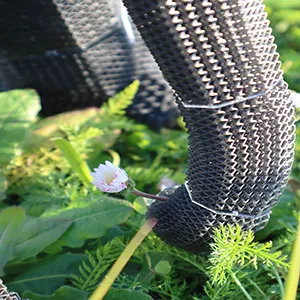
Elephant robot named 'EleBot' lifts weights and picks flowers with a foam trunk
A real elephant can curl its trunk around a flower yet balance five tons on sturdy legs. That astonishing range of motion and strength inspired engineers at EPFL, who have now designed and printed a robot they call “EleBot” that does both tricks with a single, programmable 3D‑printed foam lattice.
The study comes from the Computational Robot Design and Fabrication (CREATE) Lab. Lead author Qinghua Guan and his colleagues created this elephant‑shaped testbed that swaps multiple plastics for one clever structure.
Making an elephant robot (EleBot)
Biological tissues cover seven orders of magnitude in stiffness, from fat under 1 kilopascal to cortical bone near 30 gigapascals.
Robots usually fake that spectrum by printing layer after layer of different polymers, a slow and costly route with abrupt transitions that tear under load.
The CREATE team instead tunes stiffness geometrically. Each cell in their EleBot lattice morphs between a body‑centered cubic lattice and an X‑cube shape, two motifs whose beam angles control how easily they bend or resist shear.
“We used our programmable lattice technique to build a musculoskeletal‑inspired elephant robot with a soft trunk that can twist, bend, and rotate, as well as more rigid hip, knee, and foot joints,” said Guan.
By sliding smoothly from flexible to stiff, the trunk can pick a 0.1 millimeter wire or lift a 1 pound weight without swapping materials.
Shaping robot foam
A single four cell cube can be arranged in roughly 4 million unique ways; add one more cell and the search space tops 75 million.
That variety comes from two “programming dimensions”: altering each cell’s shape along the BCC–X‑cube spectrum and rotating or shifting cells so their beams overlap in novel patterns.
Other groups have shown that offsetting the central struts of a BCC foam boosts energy absorption twofold.
EPFL’s approach bundles those insights into a single design framework, so stiffness, anisotropy, and connectivity can be dialed up or down like RGB sliders in graphics software.
The team’s printed cubes span 20-280 kilopascals in Young’s modulus, crossing the gap between soft tissues and firm cartilage. Yet every part is the same silicone‑based resin, slashed into airy struts that keep weight low.
Building EleBot with one foam
To show practical value, the researchers built three tendon‑driven modules. A gradient trunk uses softer lattice at the outer radius and stiffer beams inside so a single cable can bend it 70 degrees with no kinks.
A uniaxial “knee” bends 50 degrees thanks to double stacked X‑cube cells acting as ligaments around a quadruple stacked, rock solid core.
A biaxial “ankle” swaps orientations to give 40 degrees of tilt in any direction while blocking unwanted twist.

Soft robot specialists previously needed vacuum jamming bags or dense networks of pneumatic chambers to match such multimodal motion.
The foam lattice hits that versatility with four off the shelf hobby servos and a handful of fishing lines.
Robot foam helps beyond elephants
Lightweight, hollow lattices shed drag in water and air, a major plus for drones or underwater rovers. NASA has already tested reconfigurable truss metamaterials for space habitats that combine high stiffness with self assembly.
Programmable lattices can also house wires, microfluidic channels, or embedded sensors without drilling holes. That integration could lead to artificial limbs where muscles, nerves, and bones grow from the same print job.
A recent review argues that geometry based metamaterials outperform multi-material blends when designers need on the fly tuning. EPFL’s foam validates that thesis at device scale, bridging academic theory and field robots.
Elephant robots with smarter foam
Guan’s group is already thickening beam walls to push stiffness into the megapascal range required for load bearing exoskeletons.
They also plan to impregnate the open cells with conductive ink so the structure senses strain, turning the lattice itself into a nervous system.
“Like honeycomb, the strength to weight ratio of the lattice can be very high, enabling very lightweight and efficient robots,” added Benhui Dai, EPFL doctoral student.
Future versions could swap silicone for recyclable thermoplastics or biodegradable corn starch resins, shrinking the environmental footprint of large scale prints.
The CREATE lab has released its design code as open source, meaning hobbyists could print lattice toys on consumer SLA printers this year.
If that happens, the line between soft toys, compliant grippers, and walking machines may blur faster than expected.
EleBot, foam, and future elephant robots
EleBot itself is more demonstrator than safari attraction, standing under 2 feet high. Even so, its trunk can wrap a daisy without bruising petals, and its legs can kick a bowling ball, two feats rarely seen in the same machine.
By showing that geometry, not chemistry, can give foam both tenderness and grit, EPFL hints at a future where a warehouse of single material filament is enough to build factory cobots, medical devices, and disaster response bots on demand.
Nature spent millions of years evolving mixed tissue; engineers might catch up with a million printable cells.
The study is published in Science Advances.
—–
Like what you read? Subscribe to our newsletter for engaging articles, exclusive content, and the latest updates.
Check us out on EarthSnap, a free app brought to you by Eric Ralls and Earth.com.
—–













